Samuel Oakman and Boston Insulator Production
by Bill Snell
Reprinted from "Crown Jewels of the Wire", September 1988, page 6
(Part I, Part II in November, 1988)
Can you imagine what your insulator collection would be like if Samuel Oakman
never lived? Obviously all the Boston Bottle Works, American Insulator Company,
and Oakman Manufacturing Company pieces would not exist. But his patents had a
profound influence on other companies' insulator designs as well. That means you
would have to eliminate all your CD 145 beehives and any Columbias. Next you can
eliminate all your cable tops: any helmets, mickey mouses, or other top groove
styles. That leaves only 75 or so CD numbers! Insulator collecting sure wouldn't
be what it is today.
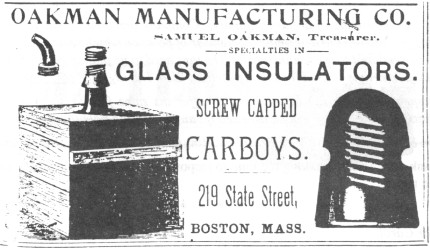
Samuel Oakman was born in February of 1822 to a Mr. and Mrs. Samuel Oakman of
Charlestown, Massachusetts. The Oakmans were an old New England family descended
from another Samuel Oakman who settled in Maine in the mid-1650s. The island
at the mouth of the Spurwink River, near Scarborough, Maine, is named Oakman
Island after him.
The Samuel Oakman we are familiar with grew up in Charlestown and married his
first wife, Eliza, in the mid-1840s. Shortly thereafter he went into business
with his sister's husband, Benjamin Eldridge, as a dealer in coal, kerosene, and
other fuels. The Oakman & Eldridge partnership occasionally dabbled for a
year or so in other ventures, such as a lumber company and a bonded warehouse.
The office of Oakman & Eldridge Fuels was at 99 State Street in Boston.
In 1865 Benjamin Eldridge died. Although Oakman & Eldridge remained in
business until the 1870s, it appears to be the time Samuel Oakman became interested in the glass business
and applying for patents. The very first of his many patents was issued on March
23, 1869, for a glass furnace, and in that same year Massachusetts Glass Company
appears in the Boston City Directory, with Oakman listed as treasurer.
On July
26, 1870, he was granted the first of his insulator patents for an insulator
shaped very much like CD 796 with a slotted threadless pinhole. The insulator
had a matching pin with an iron wedge forced into a slot in the top, causing the
pin to spread the fit snugly into the pinhole slots. A few examples of the
Oakman slotted pinhole threadless are known to exist. Some are found embossed
OAKMAN'S PATENT JULY 26, 1870 around the pin-hole, while others are unembossed.
These have been assigned CD 728 and 796. The unusual shape of the CD 796, which
has lead many to nickname it "transposition," is mentioned in the
patent description as a modification of the typical "hat" design of
the period, with the flaring top to act as a protective shield against rain. The
actual CD 796 specimen, though, has a wire groove added at the top of the
shield. Perhaps the moldmaker was confused as to where the wire was to be
attached. These were probably produced by Massachusetts Glass Company, al-
though they did not advertise insulators. The company offices were listed at 99
State Street, the same address as Oakman & Eldridge, in 1869; 29 Kirby
Street in 1870; and 61 Water Street in 1871.
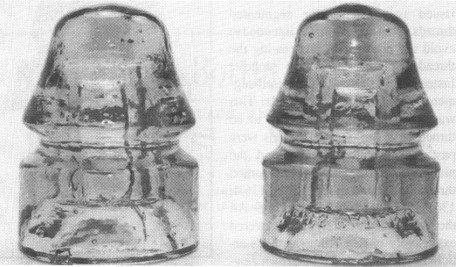
Two early Oakman threadless, CD 728, unembossed and embossed.
In 1872 Boston Bottle Works appears in the Boston City Directory, this time
with Samuel Oakman listed as agent and the offices at 49 Water Street, next door
to the location of Massachusetts Glass Company a year before. The works was
located on Mystic Avenue in Somerville, a suburb of Boston. In other directories
the sales office was listed at 97 State Street. A few slotted threadless pinhole
CD 765 pieces are embossed BOSTON BOTTLE WORKS OAKMAN'S PATENT JULY
26,1870 on the base rim and were probably made at the beginning of their
insulator production.
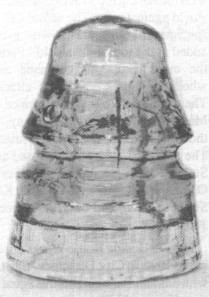
CD 765 - a rare Oakman threadless
On October 15, 1872, Oakman was issued two patents for
segmented threads. This invention was intended to avoid the problem of
unscrewing the threaded plunger from the pinhole. Instead, only three of four
raised segments were molded with threads. This way, the plunger only needed to
be turned until the plunger threads were past the insulator threads, and the
plunger could be removed. Segmented threads are found in CD 127.6, 136.4, 136.7,
143.6, 158, 158.2 and 158.9 All the segmented thread styles are covered
extensively in Ray Klingensmith's article in the August, 1979, Crown Jewels.
In
the late 1870's Boston Bottle Works apparently experienced financial
difficulties. A new group of investors was organized and Boston Bottle Works
became Bay State Glass Works, still with Samuel Oakman as agent and located at
97 State Street. The works, however, was located in Cambridge. Possibly the
Somerville works was destroyed, causing the demise of Boston Bottle Works.
Although Bay State advertised insulators, no embossed examples are known. It is
reasonable to assume they may have made the unembossed CD 136.4 with segmented
threads, and possibly the full threaded version as well. It is also possible
they produced the other unembossed segmented thread insulator or those embossed
with only the October 1872 date. Bay State folded in early 1879.
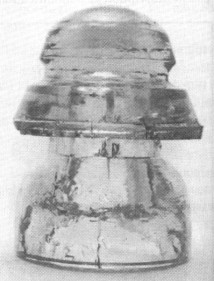
Oakman's CD 796 "transposition" threadless
There is one
insulator worthy of mention here because of its similarities to Boston Bottle
Works insulators. This is known as the "Chester Boston" and is CD 158.1, embossed on
the inner skirt CHESTER 104 CENTRE STREET NY - PATENTED-. This is generally
believed to be a product of Boston Bottle Works, specially ordered by the
Chester Telegraph Supply Company of New York.
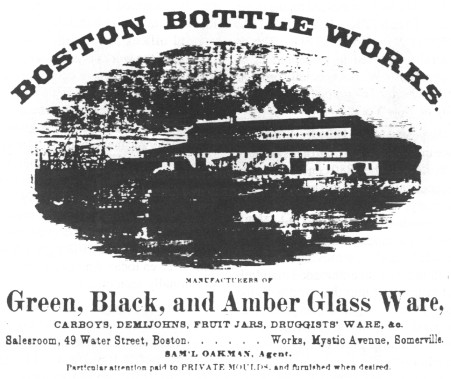
The years 1880 to 1884 are difficult to trace in regard to Oakman or his
activity in Boston. In the 1880 census he states his occupation as
"treasurer for glass company." He was also issued a patent for a
method of producing threads in glass by creating a thimble of glass on a
threaded mandrel, removing it, putting the thimble on an unthreaded mandrel, and
inserting it into the mold with the rest of the molten glass. This patent was
assigned to Edward C. Sherburne, the owner of a large glass factory that
produced mostly plate and window glass. He probably made some pressed glass
objects also, since this patent would be useless for flat glass. It is a
possibility that Oakman worked for Sherburne during these years. Insulators may
have been produced, but any examples in collector's hands today would probably
be unembossed.
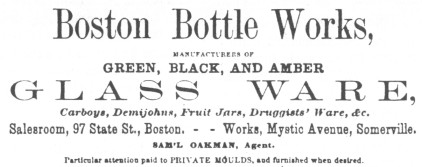
From 1884 to 1886 the New York City Directory lists Samuel Oakman as the
treasurer for American Insulator Company, located at 2 Wall Street. From 1885 to
1886 the company is also listed in Boston at 26 Equitable Building, while
Samuel Oakman is listed at 219 State Street dealing in bottles and glassware but
no insulators. However, an earlier mention of American is found in the November
12, 1883, patent issued to Oakman for the inner skirt: "assigned to the American Insulator Company of New York." From this
it may be assumed that American was organized in mid to late 1883. American had
offices in two cities, but the location of the works is unknown. One of the
offices may have been a branch sales office. Perhaps the one in New York was
opened to create more competition for Brookfield, the current giant of the
insulator business, or perhaps it was to attract the customers of the defunct
Chester Company, for which Boston Bottle Works had more than likely produced CD
158.1. Whatever the reason, American seemed to distribute more widely than the
three earlier glass companies. Even today Americans are still occasionally seen
on poles.
American produced a wider variety of styles than Boston Bottle Works or the other companies. Embossed Americans
are found in CD 105, 126.4, 134, 145, 156, 156.1, 160.7 and two one-of-a-kind
examples, CD 160.4 and 143.5. These variants were probably made unintentionally
by some tired glass worker who used the wrong plunger and an inner skirt (or
lack of one) was created. The beehive, CD 145, was Oakman's only design patent,
granted on February 12, 1884. The style immediately became popular and Western
Union utilized the beehive as its standard insulator until 1911. It remained in production
at Hemingray until 1943, a period of nearly sixty years.
There are also two styles of Postal Telegraph Company insulators that are
embossed on the rim POSTAL TELEGRAPH CO. PAT. SEPT. 13,1881. These are CD 156
and 156.1, which American very probably produced for Postal.
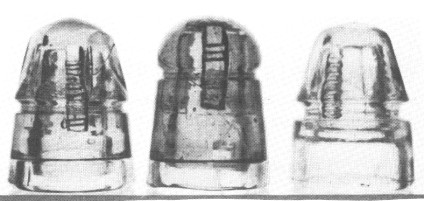
Three products of Boston Bottle Works: CD 158, 145.6, 136.7
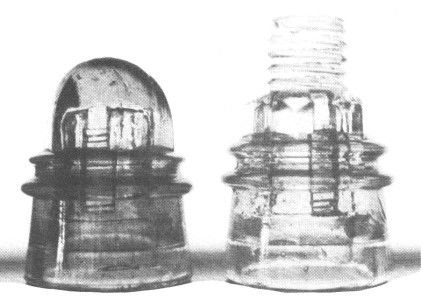
The CD 158.2 "Boston Barrel" and CD 158.9 "Screwtop"
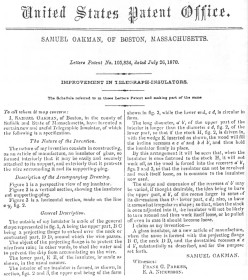
Medium Image (99 Kb)
Large Image (197 Kb)
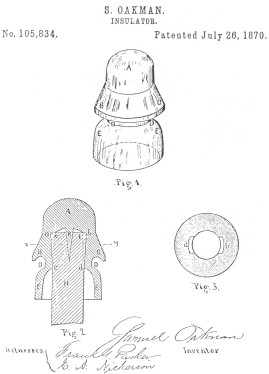
Medium Image (58 Kb)
Large Image (119 Kb)
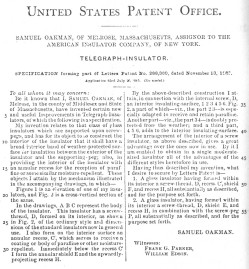
Medium Image (102 Kb)
Large Image (215 Kb)
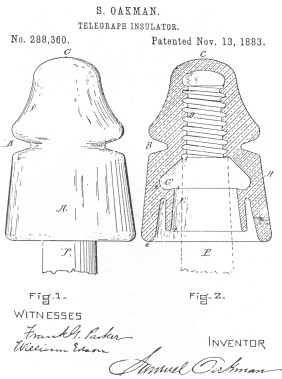
Medium Image (86 Kb)
Large Image (174 Kb)
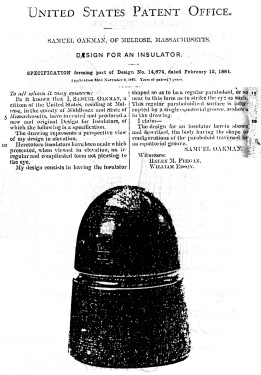
Medium Image (107 Kb)
Large Image (218 Kb)
|
